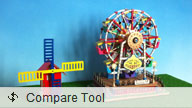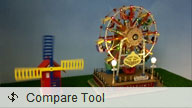Google Nexus 4 review: Royal road
Royal road
8 megapixel camera disappoints
The Google Nexus 4 packs an 8 megapixel camera, producing still shots with a resolution of 3264 x 2448 pixels. There's a single LED flash underneath it, but don't count on it doing wonders in most low-light situations.
The camera interface has been given a fresh coat of paint with an interface you'll either love or hate. With a simple tap and hold, a circle pops out giving you access to the various options. Once your finger is on a particular setting icon, it expands to reveal its options. Alternatively, you can invoke the settings circle by pressing the icon in the top right corner.
We can't help but compare it to the classic Android browser's lab feature for quick navigation, which we really liked.
The camera app lets you set the resolution, adjust the ISO, white balance and focus mode. You can also shoot HDR photos by tapping on the dedicated icon. On the right hand-side is a big blue button used for capturing. Beneath it is the camera/camcorder switch icon. From there you can choose to shoot panoramas and photo spheres, which we'll go in depth in just a second. Above the capture button is a shortcut to the settings menu.
Touch focus is available, too and works reasonably fast - just make sure you don't hold your finger for too long as the settings circle will appear.
With Android 4.0, Google introduced the Panorama capturing mode, and now with Android 4.2 Jelly Bean users will get a cool feature dubbed Photo Sphere. It's a panorama mode on steroids and allows you to capture photos in multiple directions (up, down, left, right).
The user interface is friendly and intuitive. It shows you dots which you have to aim the camera at, then rinse and repeat until you get a 360-degree Photo Sphere photo.
After they've been captured and saved as JPEG files you can view them and navigate around the whole image. You can share the image on Google+ or, if you feel like it, contribute the Photo Sphere to Google Maps.
The feature itself was inspired by Street View, as the Product Management Director for Android Hugo Barra points out. He adds that the photos pack embedded XML metadata in them allowing you to easily share them on Google+ and put them in Google+ photo albums, where your friends can view them as well.
The new interface lacks a shortcut to the Gallery app. That's because Google has replaced it with a gesture. Swiping to the right opens the Camera app's Filmstrip view. It gives you the ability to quickly discard any photos you've taken by swiping them up or down or just quickly glance at recent shots.
The image quality of the 8 megapixel camera was rather disappointing. Shots came up pretty noisy and didn't really have a lot of fine detail. Colors were relatively accurate, but contrast wasn't always great.
Here go a few samples for you to check out - keep in mind that they weren't taken in the best lighting conditions, as the weather around the office hasn't been particularly favorable lately. You can normally get slightly better output, but as we said, you shouldn't really expect miracles.






Google Nexus 4 camera samples
Photo quality comparison
Naturally, Google Nexus 4 also entered our tool, which makes it a lot easier to compare its output to the other top of the line smartphones. The tool's page will give you information on what to watch out for.
It's quite obvious that the Nexus 4 doesn't have too great an advantage over the Galaxy Nexus, which wasn't that good to begin with, and comes some way off the Galaxy S III.



Google Nexus 4 in our photo compare test
1080p video capture is not that great either
The camcorder interface of the Nexus 4 is almost the same as the still camera's - you get the same panel on the right and quick settings when you hold your finger over the viewfinder.
Videos are shot at 1080p and have a consistent 30fps framerate. The output is saved in MP4 files, having a bitrate of 12Mbps, which is rather low for high-quality 1080p capture. The good news is that they come with stereo sound with a sample rate of 48kHz.
The image quality is okay but far from the best in class. The low bitrate leads to some compression artifacts, which eats into the already unimpressive amount of resolved detail. Notice how the grass behind the windmill on the left lacks any detail, while the bits on the other side look way better.
Colors are a bit dull, too, and while the videos will easily do for less demanding users, they will hardly win the Nexus 4 any awards.
Here's a 1080p video sample (0:31s, 44.01MB) taken straight from the Google Nexus 4.
Video quality comparison
The Google Nexus 4 also enters the video quality comparison arena. It did better here, showing notable improvement over the Galaxy Nexus, but it failed to match the Galaxy S III output.
Reader comments
- james
- 05 May 2024
- Sq6
Upgradable to Android 5.1 (Lolipop)
- Anonymous
- 21 Oct 2015
- 3%F
Press power button and volume down button in the same time
- AnonD-403739
- 07 Jun 2015
- H3M
The volume of my ringtone is diminishing down to zero sound. Can anybody advise the likely cause and cure?













